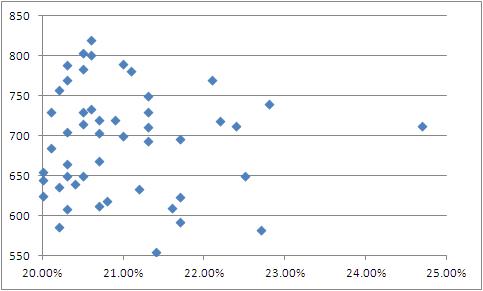The Astros and Braves: How Many K’s is Just Too Much?
We know we’re going to strike out. That’s just a given with guys who have power. And we have a lot of guys who can hit the ball out of the park. And that kind of goes hand in hand. But you look at some of the studies — and our guys have looked at them — and there’s not a direct correlation with strikeouts and offense.
— Atlanta general manager Frank Wren, interviewed by Jayson Stark on 2/18/13
Through their first two games, Braves hitters have 24 Ks in 75 PAs. But they also hit six HRs, they scored 16 runs in two games, and they’re 2-0. They’re living up to expectations. Unfortunately, so are the Astros. They have 43 Ks in 97 PAs through their first three games, becoming just the fifth team in history to strike out at least 10 times in the first three games of the season. The team is 1-2 with just 8 total runs scored. So how relevant are strikeouts to a team’s success?
The 2010 Arizona Diamondbacks set the all-time record for strikeouts, and were so displeased that they got rid of all of the worst offenders, allowing Adam LaRoche to depart as a free agent at the end of the year, trading away Mark Reynolds for a pair of relievers, trading Kelly Johnson the following summer, and finally trading away Justin Upton and Chris Young in this past offseason.
I took a look at every team from 1998 to 2012, the modern expansion era. It turns out that that was an appropriate endpoint, because pre-1998 teams simply never struck out like they have in recent years. Since 1998, 50 teams have had a strikeout rate above 50% 20%. Before 1998, only one team had ever done so: the 1968 Mets, in the thick of the Year of the Pitcher. They finished 73-89 but won a World Championship the following year.
The 2010 Diamondbacks have the highest team strikeout rate of any team, ever. Their team strikeout rate was 24.7%, and it’s nearly two percentage points higher than the number-two team, the 2001 Brewers, who are at 22.8%. Right now, the Braves are at 32.0%. The Astros are at 44.3%. What, me worry?
So there are 450 teams in the sample. First, here’s a plot of team K% against runs scored, just to give a visual sense of the spread.

(And here’s the regression: the intercept is 1029, the coefficient of K% is -1550, adjusted R2 is .127, and the finding is significant.)
Just visually, it looks like there isn’t much correlation between team strikeouts and runs at a strikeout rate below 20%. But after 20%, the runs peter off considerably, as does the sample, because only 49 of the 450 teams were above that threshold. Still, keeping small sample size in mind, here’s a blowup of that portion of the scatterplot:

The fact is, we’re in fairly uncharted waters. The 2010 Diamondbacks are the only team to crack 23%. Only six other teams have cracked 22%: the 2001 Brewers, 2012 Astros, 2012 Pirates, 2012 Athletics, 2010 Marlins, and 2008 Marlins. And their records are all over the map: the Brewers finished fourth with a 68-94 record, the Astros finished last at 55-107, the Pirates finished 79-83, the A’s were 94-68 and won the division, and the Marlins finished in third place in both years, 84-77 in 2008 and 80-82 in 2010.
So it isn’t necessarily the case that strikeouts kill you. Arguably, the 2010 Diamondbacks’ biggest problem wasn’t even the offense, it was the bullpen, which had a punishing 5.74 ERA. That fell by two runs in 2011, to a 3.71 ERA, and the Diamondbacks won their division. On the other hand, the Astros had the second-worst wRC+ in baseball last year, as well as the third-highest team K% ever, so it’s not like they’re selling out for power like the Braves are. They’re not selling out for anything. They’re just striking out a lot.
So, in conclusion, just to state the obvious: strikeouts don’t kill you, but they aren’t good. The Braves and Astros won’t continue to strike out at the same rate they are right now, but it’s a reasonable bet that they both wind up around where the Astros did last year, or the Diamondbacks did in 2010. While the Athletics proved that it isn’t impossible to go to the playoffs with that kind of performance, it certainly isn’t easy.
Baseball has changed a great deal over the years, and batters’ willingness to strike out is one of the biggest changes. Power numbers in the 1990s weren’t hugely different from the 1930s or 1950s, and the neo-deadball era of the ’80s shared a lot in common with aspects of the 1940s, 1960s, and 1970s. However, the numbers of strikeouts truly are unprecedented. It’s hard to predict from history exactly how their strikeouts will affect the fates of the Braves and Astros.
Since a homer is more good than a strikeout is bad, the Braves will be willing to live with the whiffs as long as they can make up for it with taters. But the Astros are just in for another long year.
Alex is a writer for The Hardball Times.
“Since 1998, 50 teams have had a strikeout rate above 50%. ”
This cant possibly be correct.
Typo, right?
Based on the rest of the article, I think it was supposed to be above 20% not 50%.
Obviously, I think he may mean 20% or 25%.
I’m guessing it’s meant to read 20%.
Yep, 20%. Sorry.
Hey guys, I think it was supposed to be 20%
20%